THE AURORA
Northern and Southern Lights
The aurora -- the northern and southern lights -- is
a product of magnetic fields of the Earth and Sun and of the solar wind. The Sun's gases
are in constant motion. The Sun rotates differentially with
a period of 25 days at the equator (a velocity of 2 kilometers per
second), but longer -- up to 30 days -- closer to the rotation
poles. As a result the solar gases "shear," or slide, against
themselves. The outer third of the Sun is also in a state of
convection, in which hot gases rise, radiate their heat at
the surface (which shines at temperature of 5780 Kelvin), and
thereby cool and descend. As a result of convection, the solar
surface (the photosphere) takes on a finely granulated
appearance.
The interior solar gases are ionized, electrons stripped from
atoms. Motion of an ionized gas will produce a magnetic field.
Solar rotation and convection thus combine to produce a dynamo that
generates a solar magnetic field, which because of the differential
rotation becomes concentrated into thick magnetic "ropes." The
magnetic fields float upward, and where the "ropes" loop outward
through the solar surface they inhibit the convection and thereby
cool the local gases. The result is a pair of sunspots.
The field loops are unstable and are in a continuous state of
formation, connection with each other, and collapse. The steady
release of magnetic energy heats an outer solar corona
(visible during eclipses of the Sun) to a temperature of two
million or so degrees Kelvin. The magnetic fields in turn confine
the corona into vast arc-like structures. Where the loops do not
hold the corona back, it expands to create the solar wind,
a flow of atomic particles (protons and electrons, basically
ionized hydrogen) that impacts the planets and causes the gas tails
of comets to be pushed away from the Sun.
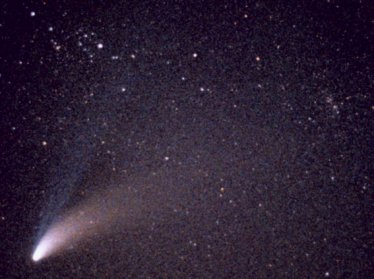 |
Comets are "dirty snowballs," made of ices into which are embedded
rocks and dust. When a comet nears the Sun, the ices sublime away
to gas, which is ionized by sunlight and pushed away from the Sun
by the solar wind to create the blue self-luminous gas tail.
The released dust is pushed away by the pressure of sunlight, which
is reflected from the tiny grains to create the white dust
tail. That comet tails point away from the Sun was the first
indication of the existence of the solar wind. (J. B. Kaler)
|
The Earth has a magnetic field that is produced by the rotation and
convection of its deep, liquid iron core (which occupies about half
the terrestrial radius and about a third of the Earth's mass).
When the wind hits the Earth, it flattens our magnetic field on the
sunward side, and stretches it out on the opposing side into a long
magnetotail. Particles trapped by the Earth's field also
form donut-shaped protective radiation belts that encompass
us. Where the particles leak into the Earth's atmosphere around
our magnetic poles, they excite the atoms of the Earth's upper air,
causing it to glow as the northern lights in a ring around
the magnetic axis (which is tilted by about 10 degrees relative to
the rotation axis). The ring's radius of about 20 degrees carries
it across Alaska and northern Canada, where aurorae are common
sights.
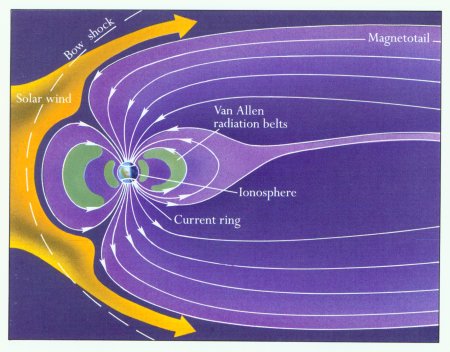 |
As the speeding solar wind hits the Earth's magnetic field, it
creates a shock wave, compresses the forward side of the field, and
stretches the far side into a long magnetotail. The field
traps particles into the donut-shaped Van Allen radiation
belts, which then protect the Earth against the wind. The
interaction of the wind and the Earth's field generate two rings of
electrical current that flow around the magnetic poles (which are
offset relative to the rotation axis) and that in turn create the
aurora. (From Stars, J. B. Kaler, Scientific American
Library, Freeman, NY, 1992.)
|
When large-scale unstable magnetic loops reconnect and collapse,
great balls of coronal gas are released from the Sun at high speed.
If such a coronal mass ejection hits the Earth (the journey
taking a couple days), it greatly disturbs our magnetic field and
causes the auroral ring to expand to lower latitudes, allowing much
of the more southerly population to see one nature's great
displays. The northern lights are mirrored by the southern lights
that center on the south magnetic pole, and expand northward during
impacts of coronal mass ejections.
The set of eight pictures below was taken at a latitude of 40
degrees north during the great display of November 19, 2004. They
are arranged not so much in a strict time sequence, but in an
aesthetic sequence that better displays the aurora's constantly
changing nature and its amazing colors.
Please enjoy them.
The constellation Gemini (the
Twins), with bright Castor and Pollux, is seen rising to the right in
pictures 1 and 2, with Saturn down below. Pictures 3 and 4 show
Castor and Pollux off to the far lower right. The bright star at
upper center in pictures 6, 7, and 8 is Polaris (the North Star) in Ursa Minor (the Smaller Bear).
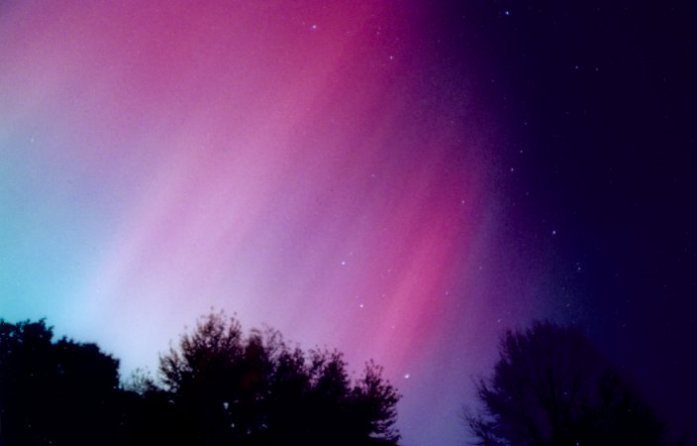
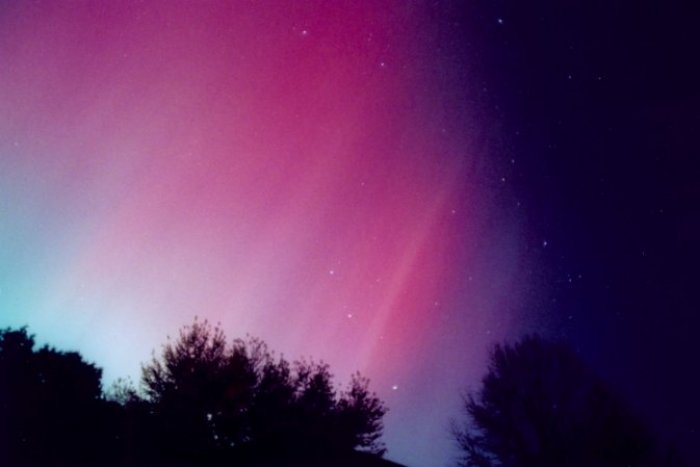
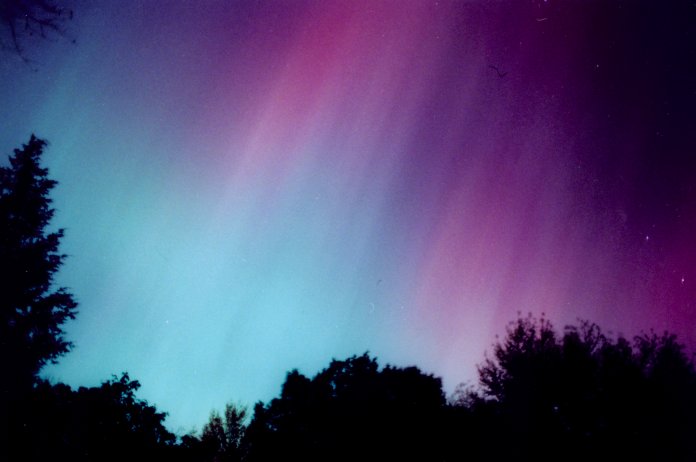
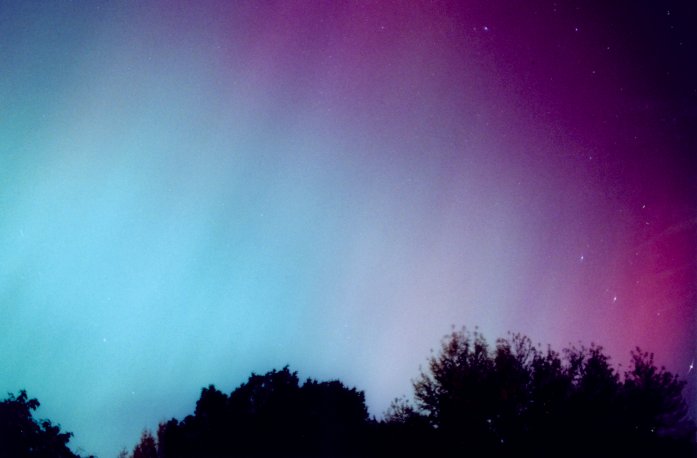
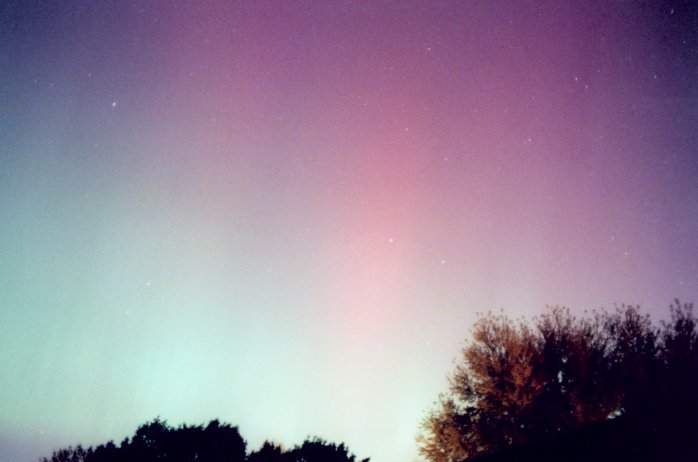
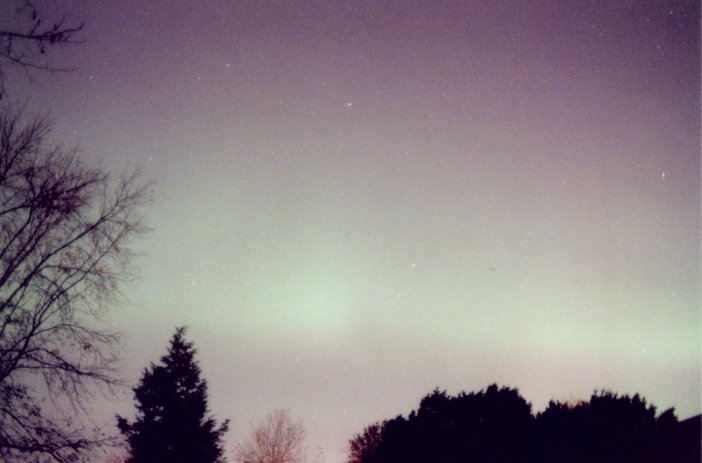
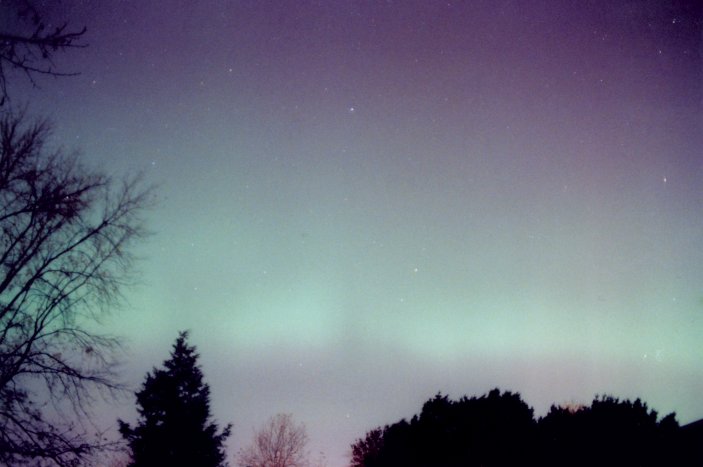
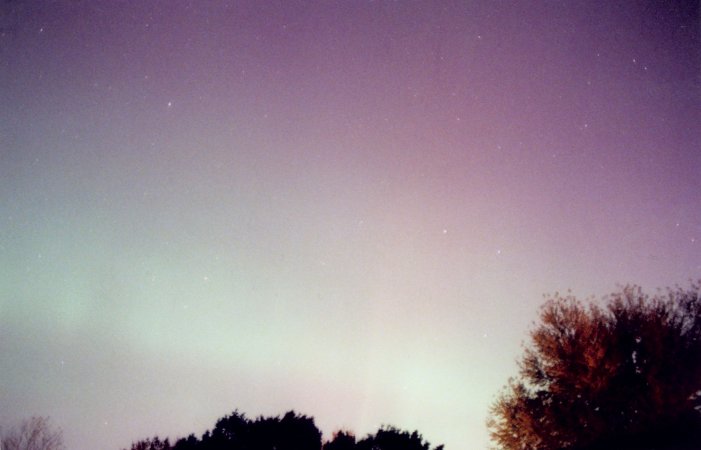
 Copyright © James B. Kaler, all rights reserved.
The written contents and photographs are the property of the author
and may not be reproduced in whole or in part without the author's
consent except in fair use for educational purposes.
Thanks to reader number
Copyright © James B. Kaler, all rights reserved.
The written contents and photographs are the property of the author
and may not be reproduced in whole or in part without the author's
consent except in fair use for educational purposes.
Thanks to reader number  .
.










